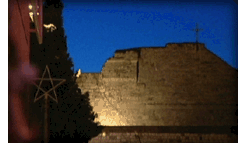| 

 On April 2, Israeli tanks rolled into the West Bank town of Bethlehem, as
part of a military campaign to hunt down Palestinian terrorists. Fleeing from
the Israeli troops, some 200 Palestinians--among them dozens of armed
militants--stormed into one of the holiest sites in Christendom, the Church
of the Nativity, which many believe is built over the birthplace of Christ. The
Palestinians remained there for thirty-eight days, surrounded by Israeli
troops and with food and water supplies dwindling, in a standoff that kept the
world transfixed.
On April 2, Israeli tanks rolled into the West Bank town of Bethlehem, as
part of a military campaign to hunt down Palestinian terrorists. Fleeing from
the Israeli troops, some 200 Palestinians--among them dozens of armed
militants--stormed into one of the holiest sites in Christendom, the Church
of the Nativity, which many believe is built over the birthplace of Christ. The
Palestinians remained there for thirty-eight days, surrounded by Israeli
troops and with food and water supplies dwindling, in a standoff that kept the
world transfixed.
It became a five week waiting game. The Palestinians felt safe inside the
church compound, knowing that the Israelis would be unwilling to storm the holy
site, for fear of igniting world-wide outrage. The Israelis knew that
eventually conditions inside the church would become unbearable, forcing the
Palestinians out. In the meanwhile, they sought to maintain the delicate
balance between diplomatic persuasion and military might.
In "The Siege of Bethlehem," FRONTLINE reveals the secret negotiations,
strategies, and maneuvers employed by the Israelis to end the confrontation.
Filmed throughout the last three weeks of the thirty-eight day standoff, the
documentary takes viewers behind the scenes in Manger Square, an area that was
off-limits to most of the international press. [Note: This film was reviewed by Israeli
military censors for security purposes.]
"The Siege of Bethlehem" spotlights both the delicate
negotiating process aimed at ending the siege and the military pressure exerted
by the Israeli Army to force the Palestinians to leave the church.
Viewers witness the negotiated release of the first non-combatants from the
church: nine Palestinian boys. As Israeli sharpshooters cover the church's
windows, the boys leave the church, escorted by priests and bearing coffins
holding the bodies of two policemen killed earlier in the siege. After the
boys are released, FRONTLINE accompanies them back to their homes, where they
recount their experiences inside the church.
"The last martyr was killed yesterday," seventeen-year-old Fahed tells his
family. "He was going to the WC when they hunted him down. Another one went
out to charge the cell phone, they shot him in the stomach and he died. Anyone
who approached to drag them, the wounded, they start shooting at him."
As the siege drags on, Israeli Lt. Colonel "M" describes the sticking points
that are hindering negotiations with the Palestinians. "There are two taboos,"
he tells FRONTLINE. "The Palestinian will not agree on an imposed deportation,
will not agree to be sent to Israeli jails. And Israel will not agree for
those with Israeli blood on their hands to go freely to Gaza. I mean they will
have to pay, to be investigated.
"So between those taboos," he says, "is a very narrow path."
But the documentary also reveals how the Israeli negotiators are not just dealing
with the Palestinians but also battling the shifting agendas of the Israeli secret service
and the international community, especially the U.S. In the end, many moves and counter-moves prolonged the
deadly thirty-eight day siege, in which seven were killed and more than a dozen
wounded, including four Israeli soldiers.
On May 10, 2002 the seige ends. All Palestinians leave the church.
The 13 men most wanted by Israel are flown to Cyprus; 26 others, banished from the West Bank, are taken to Gaza.
Not long after, European Union negotiators arrange for 12 of the 13 most wanted men to be
sent to several countries in Europe: Spain, Portugal, Ireland, Greece, Belgium and Italy. The last man, the
one most wanted by Israel, still is in Cyprus (as of June 13, 2002) waiting for a country to accept him.

home + introduction + chronology of the siege + discussion + links & readings
producer's chat + tapes & transcripts + press reaction + credits + privacy policy
FRONTLINE + wgbh + pbsi
photograph © 2002 reuters newmedia, inc./corbis
web site copyright WGBH educational foundation
| |